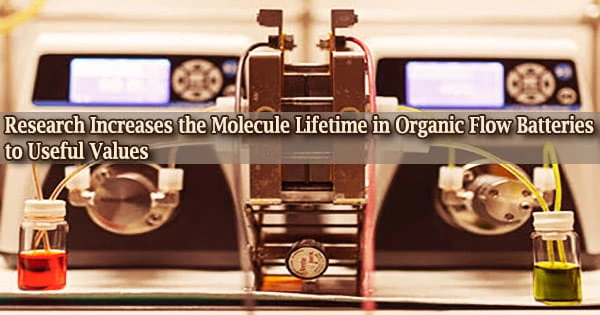Together with colleagues from the University of Cambridge, researchers at the Harvard John A. Paulson School of Engineering and Applied Sciences (SEAS) have created a new technique to significantly increase the lifespan of organic aqueous flow batteries, enhancing the technology’s commercial viability and making it possible to store energy from renewable resources like wind and solar safely and affordably.
“Organic aqueous redox flow batteries promise to significantly lower the costs of electricity storage from intermittent energy sources, but the instability of the organic molecules has hindered their commercialization,” said Michael Aziz, the Gene, and Tracy Sykes Professor of Materials and Energy Technologies at SEAS. “Now, we have a truly practical solution to extend the lifetime of these molecules, which is an enormous step to making these batteries competitive.”
The research is published in Nature Chemistry.
Aziz and Roy Gordon, the Thomas Dudley Cabot Professor of Chemistry and Professor of Materials Science, have worked together for the past ten years to create organic aqueous flow batteries that store and discharge energy using molecules called anthraquinones, which are made of naturally abundant elements like carbon, hydrogen, and oxygen.
Regardless of how frequently the battery has been used, the team’s study has shown that these anthraquinones break down gradually over time.
In earlier research, scientists discovered that by exposing one of these molecules to the air, known as DHAQ but affectionately known as the “zombie quinine” in the lab, they could increase the lifetime of the molecule.
The name “anthraquinone” refers to the fact that the researchers discovered that if the molecule is exposed to air at precisely the appropriate point in its charge-discharge cycle, it will take oxygen from the air and transform back into the original anthraquinone molecule as if it were rising from the dead.
Organic aqueous redox flow batteries promise to significantly lower the costs of electricity storage from intermittent energy sources, but the instability of the organic molecules has hindered their commercialization. Now, we have a truly practical solution to extend the lifetime of these molecules, which is an enormous step to making these batteries competitive.
Professor Michael Aziz
However, routinely exposing a battery’s electrolyte to air isn’t precisely practical because it throws the balance of the battery’s two sides, making it impossible for both sides to be fully charged at once.
The researchers worked with scientists at the University of Cambridge in the UK to better understand how the molecules break down in order to come up with a more useful strategy. They also developed an electrical technique to reverse the process.
The team discovered that if they performed a procedure known as a “deep discharge,” in which the battery’s positive and negative terminals are drained until there is no voltage difference between them, and then switched the battery’s polarity, making the positive side forcefully negative and the negative side positively positive, it produced a voltage pulse that could restore the original state of the decomposing molecules.
“Usually, in running other kinds of batteries, you want to avoid draining the battery completely because it tends to degrade its components,” said Yan Jing, a postdoctoral fellow at Harvard and co-first author of the paper. “But we’ve found that this extreme discharge, up to actually reversing the polarity, can recompose these molecules which was a surprise.”
Similar to a pacemaker, the technique periodically shocks the body to bring back life to broken-down molecules. In contrast to other studies, the researchers in this publication showed a net lifetime that was 17 times longer.
The researchers showed an even bigger increase in lifetime, up to 260 times longer, leading to a loss rate under 10% per year in further study that improved the technique. That investigation has not yet been published.
“Getting to a single digit percentage of loss per year is really enabling for widespread commercialization because it’s not a major financial burden to top off your tanks by a few percent each year,” said Aziz.
The intellectual property connected to this project has been safeguarded by Harvard’s Office of Technology Development, which has leased the technology and other associated patents on quinone flow batteries to a startup pursuing its commercial development, Quino Energy.
Additionally, the research team showed that this strategy is effective for a variety of organic compounds and deep discharge procedures, both with and without polarity reversal. The scientists will then investigate how much longer they can make DHAQ and other widely available anthraquinones last in these systems.
“Flow batteries can be expected to be the next wave in storage technology beyond Lithium particularly batteries with organic electrolytes,” said Imre Gyuk, Director of the Department of Energy’s Office of Electricity Storage program.
“This work allows control of the decomposition process, thus greatly extending the lifetime and enabling applications for medium- and long-duration energy storage.”
The research was co-authored by Evan Wenbo Zhao, Marc-Antoni Goulet, Meisam Bahari, Eric M. Fell, Shijian Jin, Ali Davoodi, Erlendur Jónsson, Min Wu, Clare P. Grey, and Roy G. Gordon. It was supported by the U.S.
National Science Foundation through grant CBET-1914543, by U.S. DOE award DE-AC05-76RL01830 through PNNL subcontract 535264, and by a grant from the Massachusetts Clean Energy 393 Center.





